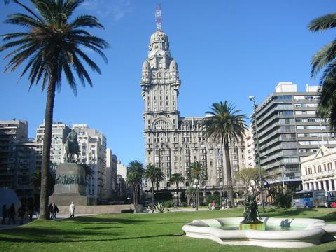By Lawrence Selby - Guest blogger traveling in Montevideo.

It's always been my opinion that the best way to get to know a city is simply to walk around a lot and take a look. I'm well into my second week now, so I've had plenty of opportunities to explore the city. I try to take long walks at least every other day; it's a great way to relax and get a bit of exercise. The more that I come to know this place, I'm inclined to agree with what the Rough Guide said. Montevideo is a thoroughly likeable small city that is easy to get a feel for. It's also a bit eclectic and strange in a nice sort of way.
From tourist standpoint, the major thoroughfare is La Rambla. La Rambla is a boulevard along the Rio de la Plata which runs roughly west to east for about 15 km from the Ciudad Vieja (old city) to the wealthier outskirts of the city along the beach at Carrasco (near the airport). La Rambla has many names. Every km or so the name changes. Some of the names that I've seen include: Rbla Francia, Rbla Armenia, Rbla President Wilson, Rbla Mahatma Gandhi, … I'm sure that there's a reason that they chose these names and this scheme though it does strike me as a bit strange.
There are many statues and monuments along La Rambla and the surrounding areas. Again, there doesn't seem to be too much of a pattern. I saw a monument dedicated to Confucius, another to some sort of Neptune goddess, and a Jewish holocaust memorial (which in itself isn't strange, but the monument is rather bizarre). I also saw a bronze statue dedicated to some guy with a Spanish name that lived approximately 100 years ago. This last statue probably made the most sense to me. There are beaches along many stretches of La Rambla and also a small harbor, soccer fields, parks and the occasional restaurant or cafe. Every time that I've seen it, the water has always been a sort of light chocolate brown color, though I'm told that this does change at times.
People tell me that this is because of the silt runoff upstream and not pollution. There is some graffiti in spots and the infrastructure and surrounding buildings are a bit run down in places.
It doesn't seem dangerous, though. I'm told Montevideo has one of the highest per capita police forces in the world. When the weather is nice, there's always a small crowd relaxing and strolling along La Rambla in Pocitos (one of the wealthier barrios about 5+ km from the Ciudad Vieja).
The Ciudad Vieja is probably the top tourist attraction in Montevideo. It's a small area (probably one km square) located between the old port and El Centro barrio. As the name implies, the Ciudad Vieja is the original Montevideo and is composed of Spanish style antique row houses. There are a few pretty squares and (of course) more statues and monuments.
Most of the statues in this area are more traditional, usually a man on a horse with a sword drawn (or with some similar pose). As I wandered into the area, I felt a comfortable feeling of recognition with the energy and vibe. For lack of better words, it seems a little bit like the West Village (in New York City) with the old buildings and architecture of Seville, Spain. The thing that I found most interesting about the place (and maybe I'm a bit strange for feeling this way) is that the restoration of the Ciudad Vieja is probably about 50% complete at best. Sometimes when you stand at an intersection and look a block down the road you can see blocks of gutted and completely abandoned old ornate Spanish row houses.
So, within one glance you can see the buildings in all the various states of repair: blown out, partially repaired and completely restored. To me this contrast lends a feeling of authenticity about the place that I wouldn't have felt if it were completely gentrified. There are ¨For Sale¨ signs on many of the fringe row houses; I'm sure Donald Trump would be salivating.



 ShareThis
ShareThis
